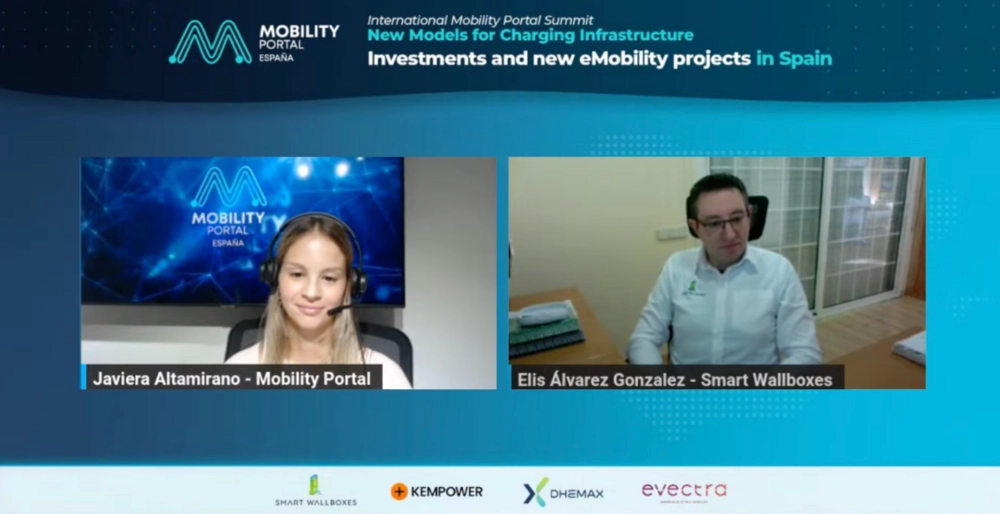“Bidirectional charging, as of today, in Spain is still in its infancy,” asserts Elis Álvarez González, CEO of Smart Wallboxes, during the “Investments and new eMobility projects in Spain” event organized by Mobility Portal España.
This technology acquires special relevance by enabling the increase of storage capacity in renewable supply networks, thanks to the bidirectionality of energy between the electric vehicle (EV) and the grid.
It has the potential to generate additional value when combined with photovoltaic installations to maximize self-consumption.
Moreover, the Ministry for the Ecological Transition and the Demographic Challenge (MITECO) contemplates this service in its Energy Storage Strategy.
It estimates that by the year 2030, the electric car fleet will provide approximately 26 GWh annually of distributed storage through V2G (Vehicle-to-grid) technology.

In this regard, the CEO states: “What is needed is swiftness regarding this issue.”
Specifically, regulations are required to drive this service at the national level, given that electric vehicle and charger manufacturers are already incorporating this technology into their products.
For example, Polestar will integrate it into its new models, although its activation will depend on the existence of a regulation governing it.
The same applies to charging points, where the current obstacle lies in the fact that installing them in a residence is unfeasible due to the lack of regulation.
“This issue already has a political connotation. I know there is a regulation in process, which several guilds have received and are reviewing,” he assures.
It is expected that this will be approved in Spain by the year 2025, while other European Union countries are already implementing it.
Germany, in particular, has announced that they will focus aid on models with bidirectional charging that feed their surplus into the electrical grid.
Likewise, vehicles could connect to provide service to appliances and homes.
This allows using batteries as energy sources for the entire grid, especially when there are a sufficient number of them.
In such cases, they can store energy during periods of low demand and supply energy during times of high prices or when solar or wind generation is limited.
“This advancement will be a great leap in terms of energy efficiency in homes,” says Álvarez González.
Noticing that numerous manufacturers already offer it in other markets, there is a growing demand for bidirectional charging from local customers.
It is expected that next year the regulation will finally be enacted and implemented, supported by regulations from vehicle and charger manufacturers, “to move forward as quickly as possible and without setbacks.”
What other charging trends are observed in the Spanish eMobility market?
One of the main objectives of electric car users is to reduce the costs associated with mobility.
Therefore, one of the preferences is to have a charging point at home or in the parking space that allows charging the car during off-peak hours.
In this context, the concept of “smart charging” emerges as an effective solution.
Smart charging equipment is equipped with load balancing systems that regulate electricity consumption to not exceed the maximum power contracted by the user in their home.
This technology allows determining optimally when, how, and in what way it is most profitable for the user to charge their vehicle.
“The trend in recent years is to offset this situation by installing self-consumption systems in order to optimize costs,” details the CEO.
This approach is particularly relevant in countries like Spain, which, according to the Institute for Diversification and Energy Saving (IDAE), is positioned as one of the world leaders in clean energy.
In fact, photovoltaic energy already represents 20 per cent of electricity generation in the country.
Spain has an energy surplus that can facilitate the transition to electric mobility, as current supply significantly exceeds demand.
At this point, Smart Wallboxes stands out.
As specialists in renewable energies, the company offers the installation of high-efficiency solar panels, allowing customers to generate their own green energy and reduce their electricity bill by up to 80 per cent.
It also designs photovoltaic systems that allow users to sell their surplus to the electric company or store it for use during the night.
This ensures a continuous supply of electricity to homes, even in the event of a supply failure.

Another emerging trend identified by the CEO is inductive charging.
“In the coming years, this technology will also have its place, as the possibility of wirelessly recharging vehicles, without the need for cables, adds additional convenience to the entire process,” he notes.
One manufacturer taking the lead in this technology is Tesla.
In recent months, the company has acquired the German company Wiferion, specialized in cableless charging for all types of electric cars.
Although it subsequently proceeded to sell it, it retained its engineers.
Alongside them, Elon Musk‘s company is immersed in the development of an inductive charging platform aimed at owners of low and zero-emission vehicles.
Relive Elis Álvarez González’s participation during the “Investments and new eMobility projects in Spain” event:








